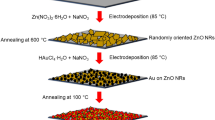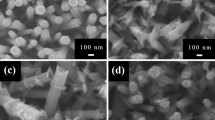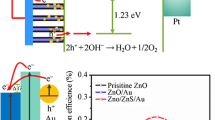Abstract
In this study, different structures of ZnO, such as nanorods (NR), nanosheets (NS), nanowires (NW), and nanospheres (NSP), were synthesized and then sensitized with Au plasmons for efficient photoelectrochemical splitting of water. The electrodeposition method was used to realize different ZnO nanostructures and decorate them with Au nanoparticles. X-ray diffraction (XRD) confirms the hexagonal wurtzite structure of ZnO photoanodes, and the average crystal size was ~ 30 nm. The morphology of ZnO nanostructures depends on the concentration of Zn(NO3)2 .6H2O, and a variation in it leads to the evolution of nanorods, nanosheets, nanowires, and nanospheres. UV–visible and photoluminescence (PL) spectroscopy give the bandgap value (~ 3.1 eV) and good absorption in the visible region on decoration with Au plasmons. The photoelectrochemical (PEC) splitting of water experiment results indicate that the photoanode of ZnO-NS (0.05 M) loaded with Au plasmons-based photoanode has better performance with 0.38% efficiency and a photocurrent density of 0.68 mA/cm2. Different ZnO photoanodes can be designed and constructed containing various types of ZnO morphology for efficient PEC water splitting, as evident from the preliminary results.









Similar content being viewed by others
Data availability
The datasets used and analyzed during the current study are available from the corresponding author upon reasonable request.
References
P. Shinde, V. Sharma, A. Punde, A. Waghmare, P. Vairale, Y. Hase, S. Pandharkar, A. Bhorde, R. Aher, S. Nair, V. Doiphode, V. Jadkar, N. Patil, S. Rondiya, M. Prasad, S. Jadkar, 2D alignment of zinc oxide@ZIF8 nanocrystals for photoelectrochemical water splitting. New J. Chem. 45, 3498–3507 (2021). https://doi.org/10.1039/D0NJ05567K
S. Sharma, S. Singh, N. Khare, Enhanced photosensitization of zinc oxide nanorods using polyaniline for efficient photocatalytic and photoelectrochemical water splitting. Int. J. Hydrogen Energy 41, 21088–21098 (2016). https://doi.org/10.1016/j.ijhydene.2016.08.131
Y. Yang, S. Niu, D. Han, T. Liu, G. Wang, Y. Li, Progress in developing metal oxide nanomaterials for photoelectrochemical water splitting. Adv. Energy Mater. 7, 1700555 (2017). https://doi.org/10.1002/aenm.201700555
P. Subramanyam, B. Meena, V. Biju, H. Misawa, S. Challapalli, Emerging materials for plasmon-assisted photoelectrochemical water splitting. J. Photochem. Photobiol. C Photochem. Rev. 51, 100472 (2022). https://doi.org/10.1016/j.jphotochemrev.2021.100472
A. Fujishima, K. Honda, Electrochemical photolysis of water at a semiconductor electrode. Nature 238, 3738 (1972). https://doi.org/10.1038/238037a0
J. Han, Z. Liu, Optimization and modulation strategies of zinc oxide-based photoanodes for highly efficient photoelectrochemical water splitting. ACS Appl. Energy Mater. 4, 1004–1013 (2021). https://doi.org/10.1021/acsaem.0c02985
M. Liu, C.Y. Nam, C.T. Black, J. Kamcev, L. Zhang, Enhancing water splitting activity and chemical stability of zinc oxide nanowire photoanodes with ultrathin titania shells. J. Phys. Chem. C 117, 13396–13402 (2013). https://doi.org/10.1021/jp404032p
S. Shet, Y. Yan, H. Wang, N. Ravindra, J. Turner, M. Al Jassim, Synthesis of ZnO nanostructures and their influence on photoelectrochemical response for solar driven water splitting to produce hydrogen. Advances and applications in electroceramics II-materials science and technology. Adv. Nanomater. Nanostruct. 229, 231 (2012). https://doi.org/10.1002/9781118144602.ch14
A.K. Chandiran, M. Abdi-Jalebi, M.K. Nazeeruddin, M. Grätzel, Analysis of electron transfer properties of ZnO and TiO2 photoanodes for dye-sensitized solar cells. ACS Nano 8, 2261–2268 (2014). https://doi.org/10.1021/nn405535j
C. Li, S. Chen, Y. Wang, Z. Hou, ZnO/ZnS heterostructures grown on Zn foil substrate by hydrothermal method for photoelectrochemical water splitting. Int. J. Hydrogen Energy 44, 25416–25427 (2019). https://doi.org/10.1016/j.ijhydene.2019.07.206
C. Cheng, K.R. Gustavsen, K. Wang, Plasmon-induced visible light absorption arising from edge-interfaces of titanium-oxides nanocomposites. Opt. Mater. 113, 110847 (2021). https://doi.org/10.1016/j.optmat.2021.110847
M.Z. Iqbal, S. Siddique, Recent progress in efficiency of hydrogen evolution process based photoelectrochemical cell. Int. J. Hydrogen Energy 43, 21502–21523 (2018). https://doi.org/10.1016/j.ijhydene.2018.09.157
S. Cho, J.W. Jang, K.H. Lee, J.S. Lee, Research update: strategies for efficient photoelectrochemical water splitting using metal oxide photoanodes. APL Mater. 2, 010703 (2014). https://doi.org/10.1063/1.4861798
Y. Liu, X. Yan, Z. Kang, Y. Li, Y. Shen, Y. Sun, L. Wang, Y. Zhang, Synergistic effect of surface plasmonic particles and surface passivation layer on ZnO nanorods array for improved photoelectrochemical water splitting. Sci. Rep. 6, 29907 (2016). https://doi.org/10.1038/srep29907
M. Prasad, V. Sharma, R. Aher, A. Rokade, P. Ilaiyaraja, C. Sudakar, S. Jadkar, Synergistic effect of Ag plasmon- and reduced graphene oxide-embedded ZnO nanorod-based photoanodes for enhanced photoelectrochemical activity. J. Mater. Sci. 52, 13572–13585 (2017). https://doi.org/10.1007/s10853-017-1436-4
H. Li, Z. Li, Y. Yu, Y. Ma, W. Yang, F. Wang, X. Yin, X. Wang, Surface-plasmon-resonance-enhanced photoelectrochemical water splitting from Au-nanoparticle-decorated 3D TiO2 nanorod architectures. J. Phys. Chem. C 121, 12071–12079 (2017). https://doi.org/10.1021/acs.jpcc.7b03566
C. Mahala, M.D. Sharma, M. Basu, Near-field and far-field plasmonic effects of gold nanoparticles decorated on ZnO nanosheets for enhanced solar water splitting. ACS Appl. Nano Mater. 3, 1153–1165 (2020). https://doi.org/10.1021/acsanm.9b01678
M. Zayed, N. Nasser, M. Shaban, H. Alshaikh, H. Hamdy, A.M. Ahmed, Effect of morphology and plasmonic on Au/ZnO films for efficient photoelectrochemical water splitting. Nanomaterials 11(9), 2338 (2021). https://doi.org/10.3390/nano11092338
S.A. Saboor, V. Sharma, E.L. Darboe, V. Doiphode, A. Punde, P. Shinde, V. Jadkar, Y. Hase, A. Waghmare, M. Prasad, S. Jadkar, Influence of Au plasmons and their synergistic effects with ZnO nanorods for photoelectrochemical water splitting applications. J. Mater. Sci. Mater. Electron. 32, 20525–20538 (2021). https://doi.org/10.1007/s10854-021-06564-4
H. Li, H. Liu, F. Wang, G. Li, X. Wang, Z. Tang, Hot electron assisted photoelectrochemical water splitting from Au-decorated ZnO@TiO2 nanorods array. Nano Res. 15, 5824–5830 (2022). https://doi.org/10.1007/s12274-022-4203-z
M. Wu, W.J. Chen, Y.H. Shen, F.Z. Huang, C.H. Li, S.K. Li, In situ growth of matchlike ZnO/Au plasmonic heterostructure for enhanced photoelectrochemical water splitting. ACS Appl. Mater. Interfaces 6, 15052–15060 (2014). https://doi.org/10.1021/am503044f
Z. Yan, H. Liu, Z. Hao, M. Yu, X. Chen, J. Chen, Electrodeposition of (hydro)oxides for an oxygen evolution electrode. Chem. Sci. 11, 10614–10625 (2020). https://doi.org/10.1039/D0SC01532F
C. Chang, S. Zhu, X. Liu, Y. Chen, Y. Sun, Y. Tang, P. Wan, J. Pan, One-step electrodeposition synthesis of bimetal Fe- and co-doped NiPi/P for highly efficient overall water splitting. Ind. Eng. Chem. Res. 60, 2070–2078 (2021). https://doi.org/10.1021/acs.iecr.0c05365
M. Zayed, N. Nasser, M. Shaban, H. Alshaikh, H. Hamdy, A.M. Ahmed, Effect of morphology and plasmonic on Au/ZnO films for efficient photoelectrochemical water splitting. Nanomaterials 1(9), 2338–19 (2021). https://doi.org/10.3390/nano11092338
X. Zheng, Z. Zhang, S. Meng, Y. Wang, D. Li, Regulating charge transfer over 3D Au/ZnO hybrid inverse opal toward efficiently photocatalytic degradation of bisphenol A and photoelectrochemical water splitting. Chem. Eng. J. s 393, 124676 (2020). https://doi.org/10.1016/j.cej.2020.124676
A.C. Guler, J. Antoš, M. Masař, M. Urbánek, M. Machovský, I. Kuřitka, Boosting the photoelectrochemical performance of Au/ZnO nanorods by co-occurring gradient doping and surface plasmon modification. Int. J. Mol. Sci. 24(1), 443 (2022). https://doi.org/10.3390/ijms24010443
X. Shao, B. Li, B. Zhang, L. Shao, Y. Wu, Au@ ZnO core–shell nanostructures with plasmon-induced visible-light photocatalytic and photoelectrochemical properties. Inorg. Chem. Front. 3(7), 934–943 (2016). https://doi.org/10.1039/C6QI00064A
W. Zhang, W. Wang, H. Shi, Y. Liang, J. Fu, M. Zhu, Surface plasmon-driven photoelectrochemical water splitting of aligned ZnO nanorod arrays decorated with loading-controllable Au nanoparticles. Sol. Energy Mater. Sol. Cells 180, 25–33 (2018). https://doi.org/10.1016/j.solmat.2018.02.020
P. Muhammed Shafi, A. Chandra Bose, Impact of crystalline defects and size on X-ray line broadening: a phenomenological approach for tetragonal SnO2 nanocrystals. AIP Adv. 5, 057137 (2015). https://doi.org/10.1063/1.4921452
A.R. Marlinda, N. Yusoff, A. Pandikumar, N.M. Huang, O. Akbarzadeh, S. Sagadevan, Y.A. Wahab, M.R. Johan, Tailoring morphological characteristics of zinc oxide using a one-step hydrothermal method for photoelectrochemical water splitting application. Int. J. Hydrogen Energy 44, 17535–17543 (2019). https://doi.org/10.1016/j.ijhydene.2019.05.109
K.R. Nandanapalli, D. Mudusu, J.S. Yu, S. Lee, Stable and sustainable photoanodes using zinc oxide and cobalt oxide chemically gradient nanostructures for water-splitting applications. J. Colloid Interface Sci. 558, 9–20 (2020). https://doi.org/10.1016/j.jcis.2019.09.086
P.J. Scherrer, Estimation of the size and internal structure of colloidal particles by means of röntgen. Nachr. Ges. Wiss. Göttingen. 2, 96–100 (1918)
J.I. Langford, A.J. Wilson, Scherrer after sixty years: a survey and some new results in the determination of crystallite size. J. Appl. Crystallogr. 11(2), 102–113 (1978). https://doi.org/10.1107/S0021889878012844
V.L. Uvarov, I. Popov, Metrological characterization of X-ray diffraction methods for determination of crystallite size in nano-scale materials. Mater. Charact. 58(10), 883–91 (2007). https://doi.org/10.1016/j.matchar.2006.09.002
G.K. Williamson, W.H. Hall, X-ray line broadening from filed aluminium and wolfram. Acta Metall. 1(1), 22–31 (1953). https://doi.org/10.1016/0001-6160(53)90006-6
X.D. Zhang, P. Wu, Y.Y. Shen, L.H. Zhang, Y.H. Xue, F. Zhu, D.C. Zhang, Liu CL (2011) Structural and optical properties of Au-implanted ZnO films. Appl. Surf. Sci. 258(1), 151–157 (2011). https://doi.org/10.1016/j.apsusc.2011.08.022
B. Yahmadi, N. Kamoun, C. Guasch, Bennaceur R (2011) Synthesis and characterization of nanocrystallized In2S3 thin films via CBD technique. Mater. Chem. Phys. 127(1–2), 239–247 (2011). https://doi.org/10.1016/j.matchemphys.2011.01.066
A. Janotti, C.G. Van De Walle, Oxygen vacancies in ZnO. Appl. Phys. Lett. 87, 122102 (2005). https://doi.org/10.1063/1.2053360
S. Fiedler, L.O. Lee Cheong Lem, C. Ton That, A. Hoffmann, M.R. Phillips, Enhancement of the UV emission from gold/ZnO nanorods exhibiting no green luminescence. Opt. Mater. Express 10, 1476–1487 (2020). https://doi.org/10.1364/OME.381527
F. Rasouli, A. Rouhollahi, F. Ghahramanifard, Gradient doping of copper in ZnO nanorod photoanode by electrodeposition for enhanced charge separation in photoelectrochemical water splitting. Superlattices Microstruct. 125, 177–189 (2019). https://doi.org/10.1016/j.spmi.2018.08.026
P.P. Patel, P.J. Hanumantha, O.I. Velikokhatnyi, M.K. Datta, D. Hong, B. Gattu, J.A. Poston, A. Manivannan, P.N. Kumta, Nitrogen and cobalt co-doped zinc oxide nanowires—viable photoanodes for hydrogen generation via photoelectrochemical water splitting. J. Power. Sources 299, 11–24 (2015). https://doi.org/10.1016/j.jpowsour.2015.08.027
N.S.K. Gowthaman, J.W. Chen, C.F. Dee, S.P. Chai, W.S. Chang, Nanostructural dimension and oxygen vacancy synergistically induced photoactivity across high surface area monodispersed AuNPs/ZnO nanorods heterojunction. J. Alloys Compd. 920, 165836 (2022). https://doi.org/10.1016/j.jallcom.2022.165836
A. Machín, M. Cotto, J. Duconge, J.C. Arango, C. Morant, S. Pinilla, V.L. Soto, E. Resto, F. Márquez, Hydrogen production via water splitting using different Au@ZnO catalysts under UV-vis irradiation. J. Photochem. Photobiol. A 353, 385–394 (2018). https://doi.org/10.1016/j.jphotochem.2017.11.050
H.M. Chen, C.K. Chen, C.J. Chen, L.C. Cheng, P.C. Wu, B.H. Cheng, Y.Z. Ho, M.L. Tseng, Y.Y. Hsu, T.S. Chan, J.F. Lee, R.S. Liu, D.P. Tsai, Plasmon inducing effects for enhanced photoelectrochemical water splitting: X-ray absorption approach to electronic structures. ACS Nano 6, 7362–7372 (2012). https://doi.org/10.1021/nn3024877
A. Wolcott, W.A. Smith, T.R. Kuykendall, Y. Zhao, J.Z. Zhang, Photoelectrochemical study of nanostructured ZnO thin films for hydrogen generation from water splitting. Adv. Funct. Mater. 19, 1849–1856 (2009). https://doi.org/10.1002/adfm.200801363
C.F. Windisch, G.J. Exarhos, Mott-Schottky analysis of thin ZnO films. J. Vac. Sci. Technol. A 18, 1677 (2000). https://doi.org/10.1116/1.582406
A. Ahmadi, M. Zargar Shoushtari, Enhancing the photoelectrochemical water splitting performance of WS2 nanosheets by doping titanium and molybdenum via a low-temperature CVD method. J. Electroanal. Chem. 849, 113361 (2019). https://doi.org/10.1016/j.jelechem.2019.113361
K. Gelderman, L. Lee, S.W. Donne, Flat-band potential of a semiconductor: using the Mott-Schottky equation. J. Chem. Educ. 84, 685 (2007). https://doi.org/10.1021/ed084p685
C. Poole, I. Darwazeh, Microwave Semiconductor Materials and Diodes Microwave Active Circuit Analysis and Design, pp. 355 (Elsevier, Amsterdam, 2016). ISBN: 8120324188, 9788120324183
R.B. Wei, P.Y. Kuang, H. Cheng, Y.B. Chen, J.Y. Long, M.Y. Zhang, Z.Q. Liu, Plasmon-enhanced photoelectrochemical water splitting on gold nanoparticle decorated ZnO/CdS nanotube arrays. ACS Sustain. Chem. Eng. 5, 4249–4257 (2017). https://doi.org/10.1021/acssuschemeng.7b00242
Acknowledgements
Shruti Shah, Vidya Doiphode, Pratibha Shinde, Ashish Waghmare, Yogesh Hase, and Bharat Bade are grateful to the Ministry of New and Renewable Energy (MNRE), Government of India New Delhi, for the National Renewable Energy (NRE) fellowship and financial assistance. Ashvini Punde is thankful to the Mahatma Jyotiba Phule Research and Training Institute (MAHAJYOTI), Government of Maharashtra, for the Mahatma Jyotiba Phule Research Fellowship (MJPRF). Swati Rahane is thankful for the research fellowship to the Chhatrapati Shahu Maharaj Research, Training and Human Development Institute (SARTHI), Government of Maharashtra. In addition, Vidhika Sharma, and Sandesh Jadkar are thankful to the Indo-French Centre for the Promotion of Advanced Research-CEFIPRA, Department of Science and Technology, New Delhi, for special financial support.
Author information
Authors and Affiliations
Contributions
ELD contributed toward methodology, formal analysis, investigation, data curation, and writing-original draft. SM contributed toward formal analysis and data curation. SS contributed toward methodology, validation, formal analysis, and investigation. VS contributed toward formal analysis, data curation, and writing-original draft. BB contributed toward conceptualization, validation, formal analysis, and investigation. SR: contributed toward data curation, formal analysis, and nvestigation. VD contributed toward methodology, validation, formal analysis, and investigation. PS contributed toward conceptualization, validation, formal analysis, and investigation. AW contributed toward methodology, formal analysis, Iivestigation, and data curation. YH contributed toward methodology, conceptualization, validation, formal analysis, and investigation. AP contributed toward methodology, validation, formal analysis, and investigation. SL contributed toward data curation, formal analysis, and nvestigation. MP contributed toward data curation, writing-review, and editing. SJ contributed toward visualization, writing-review, editing, supervision, and funding acquisition.
Corresponding authors
Ethics declarations
Competing interests
The authors declare that they have no known competing financial interests or personal relationships that could have appeared to influence the work reported in this paper.
Additional information
Publisher's Note
Springer Nature remains neutral with regard to jurisdictional claims in published maps and institutional affiliations.
Rights and permissions
Springer Nature or its licensor (e.g. a society or other partner) holds exclusive rights to this article under a publishing agreement with the author(s) or other rightsholder(s); author self-archiving of the accepted manuscript version of this article is solely governed by the terms of such publishing agreement and applicable law.
About this article
Cite this article
Darboe, E.L., Mosamem, S.A.S., Shah, S. et al. Au-sensitized ZnO nanostructures for efficient photoelectrochemical splitting of water. J Mater Sci: Mater Electron 34, 2300 (2023). https://doi.org/10.1007/s10854-023-11713-y
Received:
Accepted:
Published:
DOI: https://doi.org/10.1007/s10854-023-11713-y




